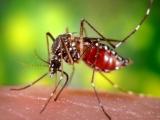A study today in monkeys showed that, under extreme and precise circumstances, Zika virus can be transmitted via saliva.
Researchers reported new findings on the transmission routes of Zika, which is normally transmitted through the bites of Aedes aegypti mosquitoes, in Nature Communications.
In the study, scientists from the University of Wisconsin-Madison used rhesus macaques with extremely high virus loads, and another set with more typical viral counts to demonstrate how and if mucosal transmission of the virus occurred in healthy monkeys.
Risk of kissing, sharing cutlery, food
"We had noticed in the literature about a year ago, there were case reports of transmission that seemed to be occurring through an oral route," said Thomas Friedrich, PhD, assistant professor of pathobiological sciences, in an interview. Friedrich said a case from France in which a man infected a woman, likely through oral sex or kissing, and another in Utah where a caregiver was probably infected by an elderly family member with extremely high viral counts, confounded researchers.
"We wanted to assess the risk, and our main concern was kissing and sharing cutlery and food," said Friedrich. "So we conducted a two-prong study to answer the following questions: Was oral transmission theoretically possible? And did it occur under normal conditions?"
Friedrich's group found that mucosal transmission of Zika is theoretically possible, but extremely unlikely under normal circumstances. All three monkeys who were exposed to high doses of Zika virus (20-fold higher than that typically found in saliva) applied directly on their tonsils developed the disease.
Another group of 7 monkeys were exposed to the virus via the saliva of monkeys who had received subcutaneous infections, representing a typical virus count. None of the monkeys exposed to doses typically found in saliva contracted the disease when their tonsils (5 animals), conjunctivae (1), or nasal passages (1) were exposed.
"We tried to simulate sneezing, sharing utensils, and other mucosal exposures," said Friedrich. "But the amount of virus typically founding saliva was not enough to infect a monkey or suggest any seroconversion [development of detectable antibodies]."
Friedrich said that semen and breast milk, two bodily fluids that contain higher amounts of virus particles than saliva, are still much more likely routes for Zika transmission.
"But it's very rare to have a virus like Zika that can be transmitted in so many ways," said Friedrich. "There may be an edge [outlying cases] of unusual transmission routes, but getting the virus through saliva doesn't seem very likely."
Virus has short infective life
In another study today that tested Zika virus infection in rhesus macaques, a separate group of researchers found that the time between cell infection and viral production is most likely short, under 4 hours, and the lifetime of an infected cell while producing virus is less than 5 hours.
Understanding the rapid infection patterns in Zika can help with the timing of antiviral medicines, said the researchers, who presented the results of their mathematical modeling analysis in the Proceedings of the National Academy of Sciences (PNAS).
See also:
Aug 1 Nat Commun study
Aug 1 PNAS study





















